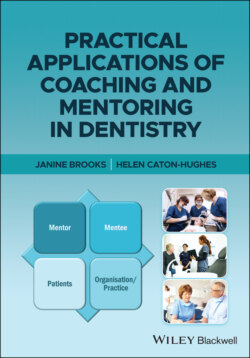Читать книгу Practical Applications of Coaching and Mentoring in Dentistry - Janine Brooks - Страница 13
Distinctions and Boundaries
ОглавлениеAs Clutterbuck outlined in 2001, there is considerable confusion over what mentoring is and what it is not. It can often be confused with other methods of professional support.
Here we make clear distinctions between counselling, advice‐giving, coaching, and other ‘talking’ interventions. The distinctions focus on three key elements of mentoring:
The type of support and level of advice that a Mentor gives a Mentee.
The way in which support and advice is offered.
The role(s) which the Mentee expects the Mentor to play.
For example:
Counsellors tend to work with clinical issues and go back to the past before going forward. It's often a one‐way relationship, with therapeutic intention.
Mentors and coaches work with successful, healthy people and start in the present, then go to the future. In both cases, a two‐way relationship is established – for example, mentors and coaches will share personal information and experience.
Coaching encourages a partnership approach in the conversation, whereas a mentor, by dint of experience, knowledge, and connections, has greater perceived status and power than the mentee.
The divide between mentoring and coaching is less clear cut. Both work by encouraging self‐discovery and self‐resolution. A mentor is more likely to be an expert in the field and has been chosen because the mentee will look for advice and guidance from the mentor. A coach does not need to have any subject knowledge in order to produce results.
The range of skills or approaches used in mentoring may include training, advice, and career counselling. Understanding the distinctions between counselling, advice‐giving, coaching, and other ‘talking’ interventions is important.
Advice‐giving may include technical advice or business advice, and it's vital that mentors only give advice within the boundaries of their professional competencies and experience.
By comparison, a coach may offer examples from their own experience, but expect the coachee to use that example as a story or metaphor, for them to make sense of within their own context rather than as advice‐giving.
This is not to set up either mentoring, coaching, or indeed any talking approach as ‘better’ or otherwise. Each has their role and benefits. The authors have been retained professionally as consultants, coaches, and mentors; their clients may, or may not, have been working separately with therapists or advisers. These are not competing modalities, rather they can be complementary. The mentee is an autonomous adult, capable of making their own decisions about what they need, and who they need to work with, in order to be personally and professionally successful.
Coaching and mentoring is also a style of leadership (Goleman et al. 2001) which can be summarised as a style of leadership that takes into account, and brings together what a person wants with the organisation’s goals.
Table 1.1 A comparison of various interventions.
| Therapy | Mentoring | Consulting | Coaching | |
|---|---|---|---|---|
| Focus of work | Deals mostly with a person's past and trauma, and seeks healing. | Deals mostly with succession training, and seeks to help the one being mentored to do as the mentor does | Deals mostly with problems and seeks to provide information (expertise, strategy, structures, methodologies) to solve the problems | Deals mostly with a client's present, and seeks to guide the client into a more desirable future. |
| Relationship | Doctor‐patient relationship (therapist has the answers) | Older/wiser‐younger/less experienced relationship (mentor has the answers) | Expert‐person with problem relationship (consultant has the answers) | Co‐creative equal partnership (coach helps client discover own answers) |
| Emotions | Assumes emotions are a symptom of something wrong | Is limited to emotional response of the mentoring parameters (succession, etc.) | Does not normally address or deal with emotions (informational only) | Assumes emotions are natural, and normalises them |
| Process | The therapist diagnoses, and then provides professional expertise and guidelines to give the client a path to healing. | The mentor allows student to observe mentor's behaviour, expertise: answers questions; provides guidance and wisdom for the stated purpose of the mentoring. | The consultant stands back, evaluates a situation, and then tells client the problems and how to fix it. | The coach stands with the client, and helps the client identify the challenges. Then they work together to turn challenges into victories. The client is held accountable to reach his or her desired goals. |
Coach‐like leaders and managers have conversations with their staff that go beyond short‐term concerns, individual performance or team goals, and instead explore the person's life, including their dreams, life goals, and career hopes. This coach‐like leaderships style has been identified as a key factor of better employee engagement (Engage for Success 2009), notably the ‘Four Enablers’ of engagement.
